#SAWCC
Photo
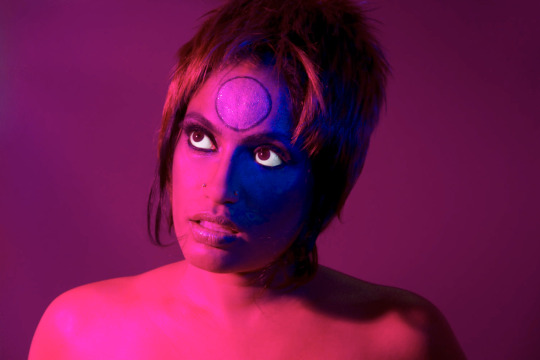
Chitra Ganesh on the Shape-Shifting Commentary of an Artist
How did you begin your practice?
I was fortunate that my parents always encouraged my interest in art, but the prospect of becoming a professional artist seemed impossible to me. Growing up, there was no one in our community who was a practising artist whom I could access as a role model. This changed on becoming involved with the South Asian Women's Creative Collective in the late 1990s and meeting other South Asians who were interested in the arts, some in a professional capacity. My mother also passed away around this time and I started working part-time and making paintings in my apartment.
Excerpt from Chitra Ganesh’s interview.
Text by Shreya Ajmani
0 notes
Photo
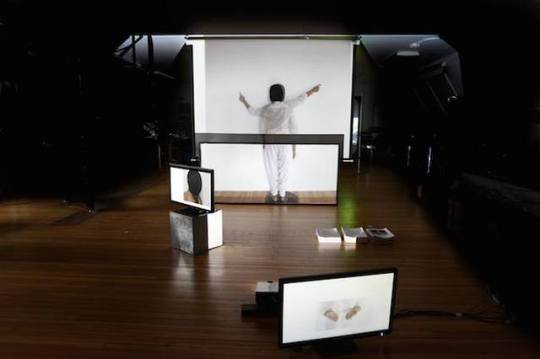
Priyanka Dasgupta, “Where Straight Lines Fail”, 2016. Installation (video, sculpture, archival documents), dimensions vary. Courtesy of the artist
The South Asian Women’s Creative Collective – SAWCC is pleased to present its 20th anniversary visual arts exhibition, ”Archival Alchemy,” guest curated by Saisha Grayson at Abrons Arts Center and featuring Parsons alumnus Patience Rustomji and faculty Chitra Ganesh.
“Archival Alchemy” will feature 13 artists and collectives from throughout the diaspora, working across artistic media to investigate the resonances found in an archival past on the contingencies of the present.
For more on the exhibit and to attend, click here.
#south asian womens creative collective#sawcc#chitra ganesh#patience rustomji#parsons#parsons fine arts#archival alchemy#abrons arts center#archival resistance#nyc#new york city#new york#manhattan#the new school#new school#artist#art#south asian women#south asian artists
0 notes
Text
Intersectionality in the Archival of Underrepresented Artists’ Works
Kimberlé Crenshaw, the founder of the idea of intersectionality, posits that a framework is required for a base understanding of intersectionality. In other words, in order to accurately represent the different ways that discrimination can be felt by individuals, a wider scope that allows for that recognition needs to be put into place and practice by authorities. This is where intersectionality comes in, allowing for multiple exclusionary practices to all be seen, recognized, and dealt with in a way that is equitable while still understanding the fundamental differences that individuals face.
This ties in heavily with many of the artists that we have been reading about. We don’t just learn about their art practices -- we learn about their genders, sexualities, backgrounds, the ways they were raised, ethnicities. All of these play a role in how certain artists are either represented or fundamentally aren’t. Ana Mendieta comes to mind, especially with the “SayHerName” movement espoused by Crenshaw. It is very reminiscent of “Where is Ana Mendieta?” The similarities of these two movements are inescapable. Ironically, despite those differences, they target two completely different worlds -- one that is far removed from art, focusing on the lack of acknowledgement of police abuse towards black women; one that is entirely art based, calling for a greater attention to female artists of color. Despite these differences, both are combined by the same concept -- intersectionality and the underrepresentation that results from similar forms of it.
The concept of intersectionality aligns very neatly with issues of archival brought up by Uzma Z. Rizvi and Jaret Vadera. They argue that “the politics of each archive is clearly evidenced by who is written in or written out, by whose authority, and by who is dismissed and invisibilized” in their essay Archives, Algorithms, and Resistance: Documenting SAWCC. In a similar manner, different degrees of intersectionality influence, as argued by Crenshaw, who can be represented by the media. A great example of this is Esther Mahlangu, a Ndebele artist who is doing everything she can do archive her people’s ancient form of art. She is the epitome of Rizvi and Vadera’s claim that “our archives stand in when our memories age, when details fall away, and when heritages are being passed from one gerneration to the next.” Her works seek to target different artists in an attempt to preserve; by painting on BMW’s, Mahlangu widens her public scope far beyond what her base intersectionality originally intended for her. At the same time, Mahlangu incorporates the core symbols utilized by her people as a means of communication, all in an attempt to allow their artistic style and substance surpass the reach of generations. By creating a school for this type of art, Mahlangu creates a sort of living archive, one vastly different and vastly more reliable than something like Wikipedia -- it is tangible and created by people who genuinely know what they are doing, or are attempting to learn, and is an in-real-life primary source of Ndebele art that is being “archived” into the next generation.
Considering again on a wider scope Rizvi and Vadera’s stance on archiving and Crenshaw’s ideas of intersectionality -- in both cases, an issue lies in a lack of recognition towards the involvement of the public. While both imply that a lack of public response to certain individuals is the root cause of the problem, neither outright state this as an issue. The problem doesn’t always lie in intersectionality, just the same as a great archive may go unnoticed -- it depends on the targeted public. Not everyone will be interested in every person, every artist to exist. There is too much information, too much to absorb for this to feasibly work -- it only makes sense, therefore, that some people or groups may go ignored by the majority. While this seems to be the ultimate problem behind mis- or under-representation, it isn’t one that can be fixed -- it is inherent, and sometimes no matter how much attention that is drawn to people like Emma DeGraffenreid, India Kager, or Esther Mahlangu, the vast majority simply isn’t going to care. It’s about the target group, the public, that should matter when considering if someone is underrepresented or not.
1 note
·
View note
Text
Archives, Algorithms, and Resistance: Documenting SAWCC
The article titled Archives, Algorithms, and Resistance: Documenting SAWCC by Jaret Vadera and Uzma Z. Rizvi discussed the reasons for why they decided to start the Art+Community Wikipedia Editathon. It talked about the biased ways of Wikipedia and also about how many people do not have the time or resources to write wikipedia pages, which makes the bias grow even more. In my last post, I discussed my thoughts after watching the Wikipedia tutorials and talked about the bias that I noticed just while researching the website’s publishing process. However, when I was researching for my own Wikipedia article about Rashin Fahandej, I was shocked at the lack of information about her. There were a few great articles about her, but almost all of them said the same exact things word-to-word, which shows just how little resources and effort are put into the discussion about minority or underprivileged artists. Furthermore, she was one of the more well-known artists with more sources written about her then others, which means that the average amount of effort shown for these artists by large companies like Wikipedia or newspapers like the New York times for example is extremely limited.
0 notes
Text
ゲストキュレーター ジャスミン・ワヒ × THE CLUBマネージングディレクター 山下有佳子 特別トークイベント
ニューヨークで活躍するジャスミン・ワヒ。
展覧会の開催に合わせての来日を記念し、1月24日(金)にトークイベントを開催いたします。
一足先に展覧会の魅力をお伝えし、また、自分らしくどう生きるかという戦略と具体例を探求していきます。
当日は、GINZA SIX 13階のTHE GRAND GINZAを会場に、銀座の夜景とシャンパンをお楽しみ頂きながらイベントにご参加頂きます。
[イベントテーマ]
マイノリティで何がわるい!色んな生き方があっていい。自分が生きたい生き方をデザインしよう!
[サービス]
Moët & Chandon グラスサービス
[参加条件]
要予約、先着50名
[申込方法]
[email protected] 宛に、参加人数と代表者様お名前フルネームご記載の上、メールをお送り下さいますようお願いいたします。
[注意事項]
・止むを得ずイベントが中止、内容変更になる場合があります。
[プロフィール]
Jasmine Wahi (ジャスミン・ワヒ)
キュレーター、アクティビスト、TEDx講演者、さらにはProject for Empty Spaceの設立者と様々な顔を持つジャスミン・ワヒの活動は、分野横断的なフェミニズムの視点を通じて、社会的言説に潜む複雑な二項対立の構造、多角的な文化的アイデンティティといった課題に取り組んでいる。
MFA(美術学修士)を取得したニューヨーク美術大学では物語性と著者性について学際的な視点からの研究を行った。
Project for Empty Spaceを運営し、インディペンデント・キュレーターとして国際展を手掛ける傍ら、ワヒはSchool of Visual Artsの教授として教育に関わり、South Asian Women’s Creative Collective (SAWCC)の役員も務めた。
ワヒの作品はWall Street Journal, Vogue, Hyperallergic, ARTNewsなど数多くのメディアに取り上げられている。
現在は愛犬のモモと共にニューヨークのブルックリンを拠点としている。
山下 有佳子 (やました ゆかこ)
1988年、東京都生まれ。慶應義塾大学卒。
ロンドンSotheby’s Institute of ArtにてArt Business修士課程を修了。
2011年より2017年まで、サザビーズロンドン中国陶磁器部門でのインターンを経て、サザビーズジャパンにてコンテンポラリーアートを担当。
主にオークションの出品作品集め、及び営業に関わり、ヨーロッパのオークションにおける戦後日本美術の取り扱い拡大に携わる。
2017年よりアートギャラリーTHE CLUBマネージングディレクターを務める。
日程 / 2020年01月24日(金)
時間 / 18:30
開場 / 19:00開始-20:00終了
場所 / GINZA SIX (13階 THE GRAND GINZA MULTIPLE HALL)
主催 / 銀座 蔦屋書店内 THE CLUB
料金 / 無料
問い合わせ先 / 03-3575-5605
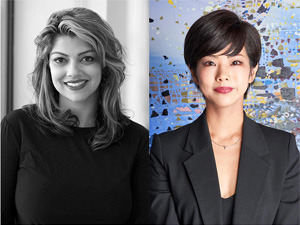
イベント情報の詳細はこちら
from honyade.com https://ift.tt/36GVKMU
0 notes
Text
SHOWS
The Chess Set & Seasoned
- The Courtyard Community - Bangaluru Feb 2019
Still Move
- Walk In Studios - Bangaluru Feb 2018
Sister Misfortune
: OED, Open Eyed Dreams – Cochin 2018
Old City Cave
- Powercut - Bengaluru - April 2018
Full House No Joker
- Powercut - Bengaluru - Feb 2018
Sister Misfortune
: - OED, Open Eyed Dreams – Cochin 2017
Old City Cave
- NUMA Bengaluru - April 2016
Sister Misfortune
- Art Chutney, Art Collective at VR Bengaluru - Feb 2016
Old City Cave
- Privacy to Piracy ,Walk In Studios - Bangaluru Oct 2015
Monsoon Festival
- Alliance Francaise New Delhi Aug 2015
Sister Misfortune & Seasoned
– SOLO SHOW - The Label Ritu Kumar, Flagship Show Room Khan Market
Launch of the collaboration project Seasoned – New Delhi 2014
Sister Misfortune
– The Taj West End – Four Wall by Art Chutney – Bangalore 2014
Sister Misfortune
– The Humming Tree – Power to the Women Event – Bangalore 2014
Sister Misfortune
– Art Loft, Event Art Hop – Mumbai 2013
Sister Misfortune
: SOLO SHOW Open Eyed Dreams – INDIA Kerala 2013
Sister Misfortune
– SOLO SHOW False Ceiling – Mumbai 2012
Trees & Their People
- Anxieties of the Periphery, OED Cochin - 2010
Kitchen Matriarch
- SAWCC
South Asian Women’s Creative Collective Annual Show – New York USA 2008
Assorted Works - MATRICES (International Show of Elektrographic Art) -
Budapest HUNGARY 2007
Assorted Works - Metrosexual Show Delhi : Red Earth - Alliance Francaise Delhi INDIA 2006
0 notes
Text
Event | Doctor’s Hours for Visual & Multidisciplinary Artists with Museum Curators

June 17 event will offer individual consultations with museum curators.
Are you in need of some career advice? The New York Foundation for the Arts (NYFA) is pleased to announce an upcoming session of Doctor’s Hours for Visual and Multidisciplinary Artists, a program designed to provide artists with practical and professional advice from arts consultants. Artists working in the disciplines of Drawing, Painting, Printmaking, Sculpture, Video, Film, Photography, New Media, Multidisciplinary, Performance Art, Socially-Engaged Practices, Folk, and Traditional Art are encouraged to participate.
Starting Monday, May 20 at 11:00 AM EST, you can register for 20-minute, one-on-one appointments with up to three museum curators to ask questions and receive actionable tips for advancing your arts career.
Title: Doctor’s Hours for Visual and Multidisciplinary Artists with Museum Curators
Program Date and Time: Monday, June 17, 2019, 6:00 PM - 9:00 PM
Location: The New York Foundation for the Arts, 20 Jay Street, Suite 740, Brooklyn NY, 11201
Cost: $38 per 20-minute appointment; three appointments limit per artist
Register: Register here to participate
To make the most of your Doctor’s Hours appointment, read our Tips & FAQs. For questions, email [email protected].
Can’t join us on June 17? You can book a one-on-one remote consultation with an arts professional via Doctor’s Hours On Call.
Consultants
Francesca Altamura, Curatorial Assistant, New Museum
Altamura is a curator and a New Yorker who holds a MFA degree in Curating from Goldsmiths, University of London, and a MA degree with Honors in History of Art from the University of St. Andrews, Scotland. At the New Museum, she recently curated Sydney Shen: Onion Master in the Window Gallery (on view until July 28) and is co-curating, with Curator Margot Norton, Diedrick Brackens’ forthcoming solo Lobby Gallery presentation, darling divined (June 4 - September 8). She has assisted on exhibitions including Nari Ward: We the People; Sarah Lucas: Au Naturel; John Akomfrah: Signs of Empire; Thomas Bayrle: Playtime; the 2018 New Museum Triennial Songs for Sabotage; and Strange Days: Memories of the Future, an off-site exhibit held in conjunction with The Store X Vinyl Factory at 180 The Strand in London. Learn more about Altamura on her website and Instagram account, @itmefrankig.
Ylinka Barotto, Assistant Curator, Guggenheim Museum
Since joining the curatorial staff in 2014, Barotto has assisted on such large-scale modern and postwar retrospective exhibitions as Alberto Burri: The Trauma of Painting (2015); Moholy-Nagy: Future Present (2016); Visionaries: Creating a Modern Guggenheim (2017), which showcased masterworks from the Guggenheim’s modern collection; and Mystical Symbolism: The Salon de la Rose+Croix in Paris, 1892–1897 (2017), for which she contributed to the catalogue text entries on many of the show’s artists. Barotto provided curatorial support for Danh Vo: Take My Breath Away (2018), and at present is assisting on Artistic License: Six Takes on the Guggenheim Collection (2019–20), the first artist-curated exhibition ever mounted at the museum. In addition to her involvement with the exhibition program, Barotto is one of the organizing curators for the Young Collectors Council, which acquires the work of emerging artists for the museum’s permanent collection. She has also hosted conversations with contemporary artists, activists, and journalists on topics such as feminism, activism, and identity and representation. Barotto received a MA degree in curatorial and museum studies at Accademia delle Belle Arti di Brera in Milan, and she is currently working toward a MA degree in art history at Hunter College, City University of New York, with a focus on postwar and contemporary feminism.
Barbara Paris Gifford, Assistant Curator, Museum of Arts and Design (MAD)
Paris Gifford is an Assistant Curator with a focus on Fashion and Contemporary Jewelry at MAD in New York City. During the past five years, she has served as part of the curatorial team for several exhibitions and various mediums, including La Frontera: Encounters Along the Border (jewelry), Counter-Couture: Handmade Fashion in an American Counterculture (fashion), Voulkos: The Breakthrough Years (ceramics), and Ebony Patterson: buried again to carry on growing… (contemporary art and jewelry). Gifford is curating two upcoming MAD exhibitions, The World of Anna Sui (fashion), which opens in September 2019, and 45 Stories in Jewelry, opening in February 2020. She has written for many publications including Metalsmith Magazine, Modern Magazine, The Journal of Modern Craft, and for the catalogs La Frontera: Encounters Along the Border, Voulkos: The Breakthrough Years, and Ralph Pucci: The Art of The Mannequin. She holds a MA degree in the History of the Decorative Arts, Design, and Culture from Bard Graduate Center.
Sophia Marisa Lucas, Assistant Curator, Queens Museum
Lucas recently organized Queens International 2018: Volumes, the eighth iteration of the museum’s biannual exhibition of Queens-based artists. The exhibition comprised a partnership with the Queens Library including installations in branches and system-wide programming. Lucas has also co-organized QM-Jerome Foundation Fellowship exhibitions by Sable Elyse Smith (2017) and Julia Weist (2017) with Hitomi Iwasaki and supported Larissa Harris on Maintenance Art (2016), a museum-wide retrospective of Mierle Laderman Ukeles. Previously, she contributed to exhibitions and programming at The Museum of Modern Art, New York; Museum of Art and Design, New York; The Artist’s Institute, New York; and Slought Foundation, Philadelphia. She is currently working with QM-Jerome Foundation Fellowship recipient American Artist on a solo project (forthcoming October 2019).
Jocelyn Miller, Assistant Curator, MoMA PS1
Miller, a member of MoMA PS1’s curatorial team since 2011, is currently organizing the upcoming exhibition Julie Becker: I must create a Master Piece to pay the Rent at MoMA PS1. She recently organized Elena Lopez Riera: Those Who Desire (2019); Maria Lassnig: New York Films 1970-1980 and Body Armor (both 2018); Past Skin (2017); and Meriem Bennani: FLY (2016), all at MoMA PS1. She also organized Projects 106: Martine Syms at The Museum of Modern Art (2017). Miller has co-organized solo exhibitions with Titus Kaphar, Reza Abdoh, Naeem Mohaiemen, Ian Cheng, Mark Leckey, Cao Fei, and Simon Denny, as well as career retrospectives of the artists Maria Lassnig and James Lee Byars, the latter both at MoMA PS1 and Museo Jumex, Mexico City. She serves as Editorial Manager for MoMA PS1’s curatorial department, overseeing museum publications, and served as Editor for the 2015 “Greater New York: Readers” series. She received her BA degree in Comparative Literature at Princeton University.
Nelson Santos, Interim Director of Curatorial Programs, Leslie-Lohman Museum of Gay and Lesbian Art
Santos has over 20 years of experience in the arts, advocacy, and non-profit sector, including leading the vision of a non-profit art organization with a social justice mission. He has worked with artists, creative thinkers, and community partners to produce and present public programs, exhibitions, visual art projects, and publications that embrace difference, dialogue, and inclusion. As an artist, educator, curator, and organizer, Santos believes art has the power to provoke, inspire, and unite. He has a history of successfully fostering new and innovative programs that reach diverse audiences and is a respected leader in the art, social justice, HIV/AIDS, and LGBTQ communities. Santos is on the Board of Directors of the Fire Island Artist Residency (FIAR) and Queer|Art|Mentorship.
Ana Torok, Curatorial Assistant, Drawings and Prints, The Museum of Modern Art
Torok is a curator and art historian based in New York City, specializing in conceptual art of the 1960s and 1970s. She earned her MA degree in Art History from the Courtauld Institute of Art and her BA degree from Barnard College, Columbia University. Prior to working as a Curatorial Assistant in the Department of Drawings and Prints at the Museum of Modern Art, she worked in the curatorial departments of the Solomon R. Guggenheim Museum and the Whitney Museum of American Art while organizing exhibitions independently.
Ambika Trasi, Curatorial Assistant, Whitney Museum of American Art
Trasi is an artist and arts organizer based in Brooklyn. Her work examines how coloniality of power is perpetuated, packaged, and sold in contemporary culture, and the role that memory, language, technology, and ritual play in decolonizing and identity-making in the diaspora. As Managing Director of Asia Contemporary Art Week (ACAW) from 2013-2017, she co-organized and assisted in the curation of performance-related exhibitions and public programs held at Asia Society, The 56th Venice Biennale, The Metropolitan Museum of Art, Hunter College Art Galleries, the inaugural Seattle Art Fair, and the Solomon R. Guggenheim Museum. As a board member of the South Asian Women’s Creative Collective (SAWCC) since 2016, she organized exhibitions presented at Queens Museum (2016) and Abrons Arts Center (2017). Trasi has a BFA degree in studio art from New York University, with a minor in South Asian studies.
This program is presented by NYFA Learning. Sign up here to receive our bi-weekly newsletter for the latest updates and news about programs and opportunities for artists.
Image: Doctor’s Hours, September 2016, Photo Credit: NYFA Learning
#doctor's hours#doctorshours#events#artist professional development#artistprofessionaldevelopment#nyfa learning#nyfalearning#announcements#instagram#multimedia artist#multimediaartist
0 notes
Text
International Women's Day 2000: Women Writers Gather to Raise Funds to Educate Afghan Girls
By Zohra Saed
From the April-June 2000 Issue of Afghan Magazine
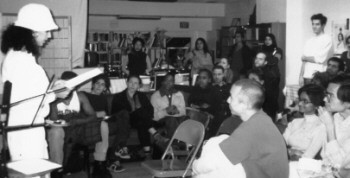
On March 8th, in celebration of International Women's Day 2000, the New York City underground was sweetened with prose and poetry as the Asian American Writers' Workshop hosted the first event in a potential monthly reading series that will sponsor the education of orphan girls.
The event was to benefit the Help the Afghan Children Inc's project to educate Kabul street children. The program educates young girls while providing them with housing, food, clothing, and land mine awareness lessons.
The following writers dedicated their talents at the workshop:
Suheir Hammad, a New York City-based Palestinian-American poet, read her latest poems about women and survival. Her first collection of poems, Born Palestinian, Born Black, and her memoir, Drops of This Story, were published in 1996.
Bruna Mori, a widely published poet, freelance journalist, and writer for Razorfish.com, read a collection of abstract poems.
Annemarie Kattan Jacir, a New York-based Palestinian filmmaker, award-winning screenwriter, poet, and activist read poetry that dealt with the experience of Palestinian exiles and family.
Zohra Saed read a few poems from a manuscript-in-progress that relates to the Soviet-Afghan war and the experience of Afghan exiles.
Meena Alexander, poet and author of most recently The Shock of Arrival: Reflections on Postcolonial Experience, River and Bridge (poetry) and Manhattan Music: A Novel, read from her latest collection of poems.
Tara Bahrampour, author of the memoir To See And See Again: A Life in Iran and America, and journalist for the New York Times, closed the evening by reading excerpts from her book.
The audience welcomed the writers with a warm reception.
Audience member Ahimsa Timoteo Bodhran stated, "The program built bridges and acknowledged the linkage between Arab/Middle Eastern people, South Asian people, and Asian people as a whole."
Barbara Nimri Aziz, producer of Radio Tahrir on 99.5FM WBAI radio, said: "A wonderful reading with some good strong sisters. "There was a very special kind of audience with a special energy."
The success of this event would not have been possible without the generosity of the writers and organizations who donated their talent and time and helped gather the audience.
A number of organizations helped with the event: Help the Afghan Children Inc. (HTACI), Virginia-based non-profit humanitarian organization; the Afghan Women's Organization of San Diego; the Radius of Arab American Writers Inc., RAWI; the South Asian Women's Creative Collective, SAWCC; Jeannie L.Wong, Administrative Director, and Quang Bao, Managing Director, of the Asian American Writers' Workshop; the newly established Up-Set press; and Knightsbridge International, a nonprofit organization dedicated to providing humanitarian assistance and disaster relief around the world, presented a $360 check that will guarantee that one little girl will receive a year's worth of housing, food, clothing, and an education.
Volunteers also aided with the night.
Mohsin Ali Jafri, Jawiaira Jilani, Charu Gupta, Sharif Saed, and Mrs. Saed who baked treats for the night; Robert Booras, Executive Director of Up-Set press and editor/producer of the Sunset Park Art & Writing Newsletter (S.P.A.W.N) for donating the profits from his literary zine to the benefit; and the necessary connections and support of Flouran Wali.
All proceeds went to Help the Afghan Chidren Inc. For more information about HTACI, visit their website at www.htaci.com or email Executive Director, Suraya Sadeed at [email protected].
0 notes
Text
Artist Lecture: Chitra Ganesh
Throughout my high school, I used to work on an art project researching renowned feminist artists, and I came to encounter Ganesh’s work, which left a great impact on me as an artist and an activist. Ganesh is an American visual artist of Indian origin born and raised in Brooklyn, New York. She explores themes, such as gender roles, femininity in Indian mythology, visual representation of women, and erasure of the minority. Researching her biography allowed me to better understand the artist as a human being and the purpose behind her construction of themes.
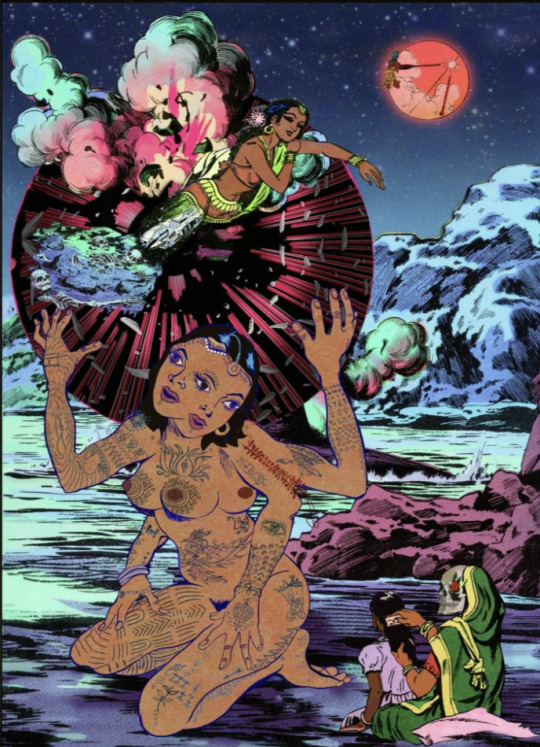
Chitra Ganesh, Atlas, 2013
One of the intriguing facts that I discovered was the artist’s struggle of making a decision of choosing art as a profession. Like her background, I was always encouraged to explore art as a hobby. Art becoming a career or a professional study is nearly non-existent in my Korean community as well. While I was able to draw parallels to her community’s perspective of art, I also found a connection on her concern of the elitism in art. Through the readings, discussions, and art seminars, I realized how the art society is driven by a small percentage of people in our community, which could easily lead to a biased direction in forming the definition of high art. I was left with the question of what would be the solution to this problem. However, Ganesh’s involvement in numerous progressive art communities in the late 1990’s made me notice how these organizations can be part of the solution. Her activity in the South Asian Women’s Creative Collective is one of the examples; SAWCC aims to provide exhibition opportunities for South Asian female artists. Since there are exclusionary aspects of the art field in consideration of cultural diversity, organizations like SAWCC can contribute to making changes.
Ganesh’s discussion of Amar Chitra Katha (ACK) was very interesting to me; ACK is a popular Indian comic series that focuses on religious and mythological narratives. Children of India and the diaspora have been reading this comic for generations. However, this well-known comic has information that maintains hierarchies of gender, skin color, and caste among others. This reminded me of how visual language can be powerful enough to shape people’s perspectives on sensitive issues. For instance, the portrayal of female characters, their dialogues, and interactions with other male characters are often biased due to the common patriarchal society in India. I find such prejudice embedded in Korean culture as well due to the deep-rooted Confucian beliefs. Since Ganesh understands the power of visual representations, she combines female characters from ACK series with her own drawings and texts to offer alternative expressions to the prescribed models of the comic. While many of the female characters in ACK are designated into subservient roles, Ganesh’s women are independent, powerful heroines. As a female artist, I admire Ganesh’s courage and utilization of the power of visual representation to reconstruct the biased understandings.
0 notes
Text
Esther and Felix
Esther Mahlangu’s geometric designs and murals have traveled far from their Ndebele origins and tradition. From her South African home to Paris, BMWs, and even vodka bottles, this internationally renowned artist has brought her culture onto the global stage. In doing so, Mahlangu has been able to share her culture without the exploitation that has historically accompanied African art’s appropriation into western culture. As many Ndebele women leave their homes bare of the colorful murals to venture into the city and away from their vanishing tradition, Esther’s efforts have become more imperative and essential to the preservation of her culture. By letting her artwork be known, appreciated, and recorded, Esther Mahlangu has memorialized the Ndebele tradition and placed it within the canon of art history. Her efforts and indisputable success bring into question the methods in which we record history. “Archives, Algorithms, and Resistance: Documenting SAWCC” relates to the issue of documentation as it questions what makes an artist or culture legitimized or “notable” to the archive’s, or Wikipedia’s, standards. It also stresses the importance of utilizing the internet or resources like Wikipedia to write our own archive and recording collective and underrepresented histories like the SAWCC or the Ndebele art form. The archive, as it stands now is expanding to include more global artists like Esther Mahlangu but not at a fast enough rate to record all that is being lost by modernization or centuries of exclusion before it can be recorded or “discovered” by the hegemony.
Through his engagement with the community and artistic practice, Felix Gonzales-Torres brought his experiences and the issues he was passionate about to his audience’s attention. His efforts live in the present, years after his death, where his conceptual artwork remains relevant as it speaks to his experiences as an immigrant, minority, and an openly gay man. While he may not have had Kimberle Crenshaw’s title to define his experience, his art representative of his intersectionality where the overlapping issues are framed for his audience to see and acknowledge. While a lot of Gonzales-Torres’s work deals with his experience as an openly gay man during the tragedy of the AIDS crisis, looking at his work after watching Crenshaw’s Ted Talk made me realize that we never hear about women in relation to the AIDs crisis. Apparently, the intersection of gender, homosexuality, and STD awareness is basically ignored “in HIV prevention and service programs.” While lesbians aren’t at the same level of risk of HIV as their male counterparts, it is still an issue that affects the community but is relatively unknown or acknowledged which places this subpopulation at a further disadvantage solely because of their intersectionality.
0 notes
Photo

Second Born (2013) - Wangechi Mutu
“These are oral cultures -- there isn’t a literary record. They say that when an old person dies, a library goes with them.” - Wangechi Mutu
This quote really exemplifies how modern artists are dealing with the issues that were brought up in Rizvi and Vadera’s essay “Archives, Algorithms, and Resistance: Documenting SAWCC.” Much like Esther Mahlangu, Mutu seems to recognize the value of listening to previous generations in an effort to retain their knowledge. Archival of previous lives in the form of oral traditions is especially difficult -- as Rizvi and Vadera point out -- because it is dependent on which points of knowledge to choose to preserve. Mutu exemplifies the idea of archiving a previous history, while not letting it define her work -- she innovates and creates new art that is in her own style, while letting the history of previous generations reside in the meanings behind the works.
0 notes
Photo

TBG X NYC :: #THEBROWNGIRLMOVEMENT
We’re on our way to the USA and nervous and excited all at the same time. All the support and encouragement from our family, friends and fellow BROWNGIRLS has been so incredible - we can’t wait to make the most of our trip and really bring the message of positivity and pride in your culture to the States.
Follow us on Snapchat (username: two-browngirls) & Twitter to keep up with our trip...
Please do spread the word and try to come along to one of the events below if you can!
________
Event: TWO-BROWNGIRLS present THE BROWNGIRL MOVEMENT
Date: Monday 21st March 2016
Time: 5.30pm
Location: NJCU School of Business, 160 Harborside, Plaza 2, Skyline Room, #233, Jersey City, NJ 07311
Tickets: BOOKING ESSENTIAL: www.tinyurl.com/gosmcsb or call (201) 200-3189
________
Event: SOUTH ASIAN WOMEN’S CREATIVE COLLECTIVE SALON
Date: Wednesday 23rd March 2016
Time: 7pm – 9pm
Location: Asian American Writer’s Workshop, 112 W 27th St, 6th floor, NYC
Tickets: Free at the door
________
#tbgxnyc#sawcc#south asian womens creative collective#nycu#new jersey city university#tbg#people#new york#south asia#diaspora
26 notes
·
View notes
Text
20 X 20: Chitra Ganesh

For my 20 x 20 Presentation, I decided to research on the artist Chitra Ganesh. Throughout my high school, I used to work on an art project researching renowned feminist artists, and I came to encounter Ganesh’s work, which left a great impact on me as an artist and an activist. Ganesh is an American visual artist of Indian origin born and raised in Brooklyn, New York. She explores themes, such as gender roles, femininity in Indian mythology, visual representation of women, and erasure of the minority. Researching her biography allowed me to better understand the artist as a human being and the purpose behind her construction of themes.
One of the intriguing facts that I discovered was the artist’s struggle of making a decision of choosing art as a profession. Like her background, I was always encouraged to explore art as a hobby. Art becoming a career or a professional study is nearly non-existent in my Korean community as well. While I was able to draw parallels to her community’s perspective of art, I also found a connection on her concern of the elitism in art. Through the readings, discussions, and art seminars, I realized how the art society is driven by a small percentage of people in our community, which could easily lead to a biased direction in forming the definition of high art. I was left with the question of what would be the solution to this problem. However, Ganesh’s involvement in numerous progressive art communities in the late 1990’s made me notice how these organizations can be part of the solution. Her activity in the South Asian Women’s Creative Collective is one of the examples; SAWCC aims to provide exhibition opportunities for South Asian female artists. Since there are exclusionary aspects of the art field in consideration of cultural diversity, organizations like SAWCC can contribute to making changes.
Ganesh’s discussion of Amar Chitra Katha (ACK) was very interesting to me; ACK is a popular Indian comic series that focuses on religious and mythological narratives. Children of India and the diaspora have been reading this comic for generations. However, this well-known comic has information that maintains hierarchies of gender, skin color, and caste among others. This reminded me of how visual language can be powerful enough to shape people’s perspectives on sensitive issues. For instance, the portrayal of female characters, their dialogues, and interactions with other male characters are often biased due to the common patriarchal society in India. I find such prejudice embedded in Korean culture as well due to the deep-rooted Confucian beliefs. Since Ganesh understands the power of visual representations, she combines female characters from ACK series with her own drawings and texts to offer alternative expressions to the prescribed models of the comic. While many of the female characters in ACK are designated into subservient roles, Ganesh’s women are independent, powerful heroines. As a female artist, I admire Ganesh’s courage and utilization of the power of visual representation to reconstruct the biased understandings.
0 notes
Text
Chairing the SAWCC Art Salon at Rich Mix London 24 April 2015
SAWCC: WORK-IN-PROGRESS SALON - open to all women. http://www.richmix.org.uk/whats-on/event/sawcc-work-in-progress-salon
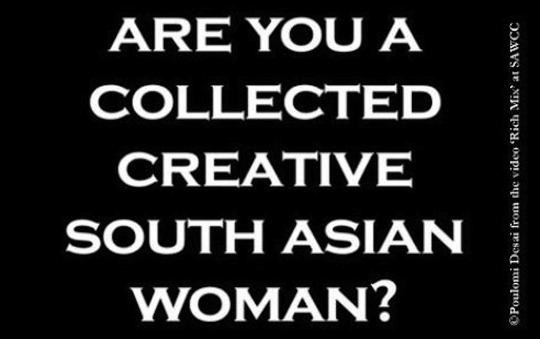
An informal salon-style gathering for female artists of South Asian origin to share creative work-in-progress, across artistic disciplines. Several artists will present unfinished work, and the space opened up for discussion and questions. Their creative projects span disciplines - including photography, visual art, and writing - as well as multi-disciplinary work.
Artists include:
Nasrin Begum & Angela Wraight, with a migration and equality-themed graphic story,
Kulwinder Bajar, with a socially engaged visual project exploring personal narrative, Ritu Mahendru, with a visual ethnography project using photography in Afghanistan, Sudipta Modi, with a multi-disciplinary international ‘trans-island-ic’ collaboration.
Chairing the salon is Poulomi Desai - multimedia artist, curator, and artistic director of Usurp Art Gallery & Studios. Desai has worked across disciplines including photography, film, music, and sound art for more than three decades. She has presented artistic work with both SAWCC New York and SAWCC London. She was recently commissioned by Sound and Music/ Google Cultural Institute/ British Music Collection to curate an online exhibition for International Women's Day, celebrating composers and sound artists.
SAWCC London's salon-style sharing circle offers supportive space to connect with fellow creative women. For artists: an opportunity to take in valuable feedback and inspiration, and to share one's artistic visions and processes. For other creative professionals and arts enthusiasts: a chance to meet established and emerging artists up close; to see and influence artistic work at early stages.
SAWCC London (pronounced “saucy”) -- the South Asian Women’s Creative Collective -- are a creative network of women artists and appreciators with origins from, or a keen interest in South Asia and diaspora. SAWCC nurture independently-forged British South Asian female creative expression across disciplines. Featuring free ‘bi-monthlies’ (often women-only), and popular public events, SAWCC offer a platform for women to share, develop, and promote creative ideas and works. Founded in 2004, SAWCC London is a sister organisation of SAWCC New York, a vibrant respected arts organisation.
Website - www.sawcc.org/community/sawcc-london
#SAWCC#art salon#South Asia#diaspora#South Asian Women’s Creative Collective#Poulomi Desai#Google Cultural Institute#Rich Mix#Nasrin Begum#Angela Wraight#Kulwinder Bajar#Ritu Mahendru#Afghanistan#Sudipta Modi#multi-disciplinary#photography#international#artists#art#ethnography#visual#migration#ideas#discursive#creative#network#text#female#women#artists salon
0 notes
Photo

Hair Cut Piece
"Rachel Kalpana James submits herself to an extreme hair cut by Svetlana Swinimer in response to wig-making practices that are sourced from “healthy, luxurious, 100% virgin cuticle hair culled directly from donors in East Indian Temples. 'Are you ready to sacrifice a lock of your hair for someone else’s beauty?'" - HAIR CUT PIECE curated by the South Asian Women’s Creative Collective (SAWCC) at the DUMBO Arts Festival.
More photos: DUMBO Arts Festival, Performance Art
#dumbo arts festival#performance art#Svetlana Swinimer#daf14#sawcc#south asian women’s creative collective#Rachel Kalpana James#dumbo#artist at work#Hair Cut Piece
2 notes
·
View notes
Link
Please Forward To Community! Project Bandhan South Asian Queers' Family Experiences...
This project seeks South Asian/Desi LGBQ and/or Trans* identified folks who are interested to participate in a visual documentation on their relationships with their families in New York City.
For more information on this project, please visit:
http://projectbandhan.wordpress.com/
Apply by September 17, 2014:
http://projectbandhan.wordpress.com/submission-application/
For any questions or inquiries, email:
[email protected]
------------------------------------------------------------------------------------->
Poster Artwork by Khushboo Gulati
--------------------------------------------------------------------------------->
This project is being supported by the South Asian Americans Leading Together (SAALT) Young Leaders Institute and will be supported entirely through donations.
THIS LOOKS AMAZING!
2 notes
·
View notes